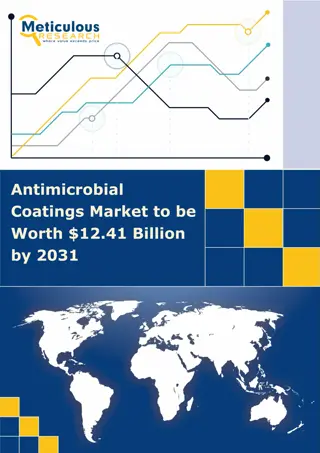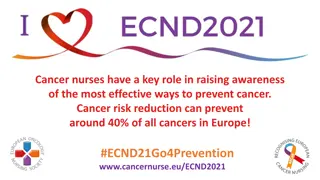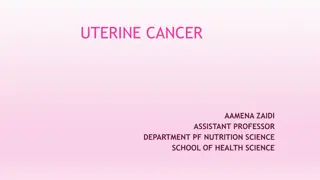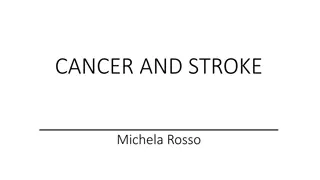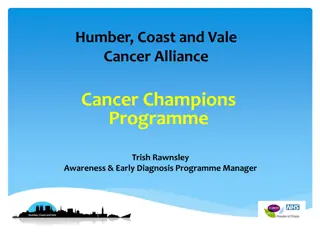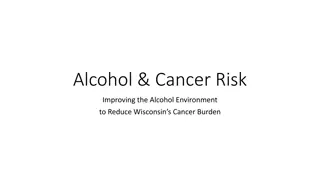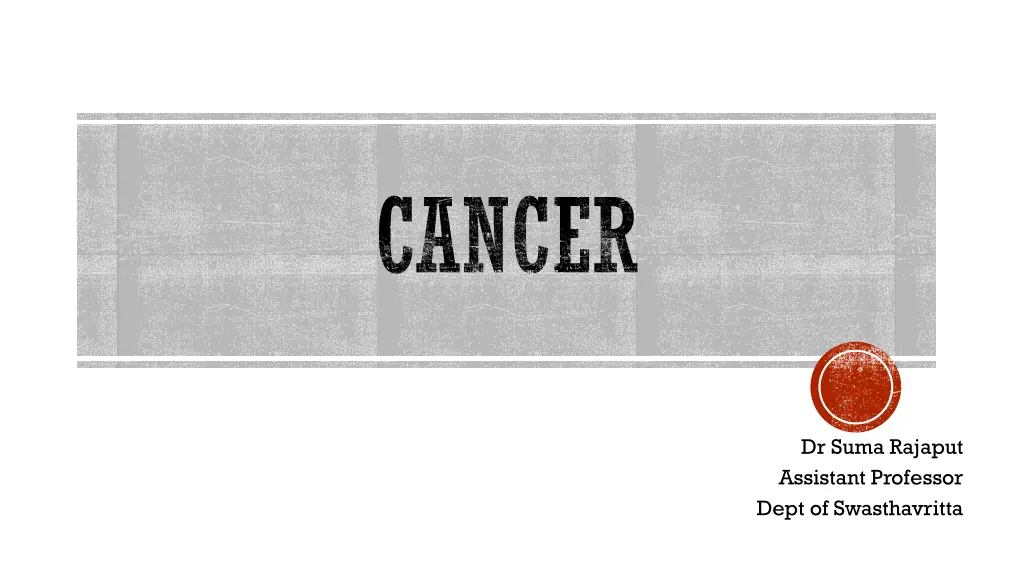
Understanding Cancer: Causes, Types, and Global Impact
Explore the world of cancer with insights on its types, causes, and global burden. Learn about environmental and genetic factors contributing to this disease, along with the most prevalent cancers worldwide. Discover key information on how environmental factors such as tobacco, alcohol, diet, and occupational exposures play a significant role in cancer development.
Uploaded on | 0 Views
Download Presentation

Please find below an Image/Link to download the presentation.
The content on the website is provided AS IS for your information and personal use only. It may not be sold, licensed, or shared on other websites without obtaining consent from the author. If you encounter any issues during the download, it is possible that the publisher has removed the file from their server.
You are allowed to download the files provided on this website for personal or commercial use, subject to the condition that they are used lawfully. All files are the property of their respective owners.
The content on the website is provided AS IS for your information and personal use only. It may not be sold, licensed, or shared on other websites without obtaining consent from the author.
E N D
Presentation Transcript
CANCER Dr Suma Rajaput Assistant Professor Dept of Swasthavritta
INTRODUCTION Cancer may be regarded as group of disease characterized by Abnormal growth of cells Ability to invade adjacent tissues and distant organs Cancer can occur at any site or tissue of the body and may involve any type of cells Major categories of cancer are Carcinoma : which arise from epithelial cells lining the internal surfaces of the varies organs Sarcoma : which arise from the mesodermal cells constituting the various connective tissues Lymphomas,myeloma,leukemia arising from the cells of bone marrow and immune systems
PROBLEM STATEMENT In the year 2020 the global burden of cancer was 19292 million new cases with 9958 million deaths The most of the deaths were because of lung cancer, liver cancer, stomach cancer, breast cancer In India, in the year 2020 the number of prevalent cases were about 27,20,251 the number of new cases 13,24,413 and the number of deaths 8,51,678 It is also reported that breast cancer is proportionately on the increase in a few metropolitan areas of India
CAUSES OF CANCER As with other chronic diseases, cancer has a multifactorial aetiology. ENVIRONMENTAL FACTORS 1. GENETIC FACTORS 2.
ENVIRONMENTAL FACTORS Environmental factors are generally held responsible for 80 to 90 per cent of all human cancers. The major environmental factors identified so far include : (a) TOBACCO: Tobacco in various forms of its usage (e.g.. smoking, chewing) is the major environmental cause of cancers of the lung, larynx, mouth, pharynx, esophagus, bladder, pancreas and probably kidney. It has been estimated that, in the world as a whole, cigarette smoking is now responsible for more than one million premature deaths each year (b) ALCOHOL:Excessive intake of alcoholic beverages is associated with oesophageal and liver cancer Some recent studies have suggested that beer consumption may be associated with rectal cancer.It is estimated that alcohol contributed to about 3 per cent of all cancer deaths
(c) DIETARY FACTORS Dietary factors are also related to cancer. Smoked fish is related to stomach cancer. dietary fibre to intestinal cancer, beef consumption to bowel cancer and a high fat diet to breast cancer. A variety of other dietary factors such as food additives and contaminants have fallen under suspicion as causative agents. (d) OCCUPATIONAL EXPOSURES These include exposure to benzene, arsenic, cadmium, chromium, vinyl chloride, asbestos, polycyclic hydrocarbons, etc. Many others remain to be identified. The risk of occupational exposure is considerably increased if the individuals also smoke cigarettes. Occupational exposures are usually reported to account for 1 to 5 per cent of all human cancers .
(e)VIRUSES: An intensive search for a viral origin of human cancers revealed that hepatitis B and C virus is causally related to hepatocellular carcinoma. The relative risk of Kaposi's sarcoma occurring in patients with HIV infection is so high that it was the first manifestation of the AIDS epidemic to be recognized. Non-Hodgkin's lymphoma, a cancer of the lymph nodes and spleen is a late complication of AIDS. The Epstein-Barr virus (EBV) is associated with 2 human malignancies, viz. Burkitt's lymphoma and nasopharyngeal carcinoma. Cytomegalovirus (CMV) is suspected oncogenic agent and classical Kaposi's a sarcoma is associated with a higher prevalence of antibodies to CMV. Human papilloma virus (HPV) is a chief suspect in cancer cervix. Hodgkin's disease is also believed to be of viral origin. The human T-cell leukaemia virus is associated with adult T-cell leukaemia/lymphoma in the United States and southern parts of Japan.
(f) PARASITES. Parasitic infections may also increase the risk of cancer, as for example,schistosomiasis in Middle East producing polyp carcinoma of the bladder. (g) CUSTOMS,HABITS AND LIFESTYLES:To the above causes must be added customs, habits and lifestyles of people which may be associated with an increased risk for certain cancers. The familiar examples are the demonstrated association between smoking and lung cancer,tobacco and betel chewing and oral cancer,etc (14) (h) OTHERS There are numerous other environmental factors such as sunlight, radiation, air and water pollution, medications (e.g., oestrogen) and pesticides which are related to cancer
GENETIC FACTORS Genetic influences have long been suspected. For example, retinoblastoma occurs in children of the same parent. Mongols are more likely to develop cancer (leukaemia) than normal children. However,genetic factors are less conspicuous and more difficult to identify. There is probably a complex interrelationship between hereditary susceptibility and environmental carcinogenic stimuli in the causation of a number of cancers.
CANCER CONTROL Cancer control consists of a series of measures based on present medical knowledge in the fields of prevention, detection, diagnosis, treatment, after care and rehabilitation, aimed at reducing significantly the number of new cases. increasing the number of cures and reducing the invalidism due to cancer
PRIMARY PREVENTION (a) CONTROL OF TOBACCO AND ALCOHOL CONSUMPTION Primary prevention offers the greatest hope for reducing the number of tobacco-induced and alcohol related cancer deaths. It has been estimated that control of tobacco smoking alone would reduce the total burden of cancer by over a million cancers each year (16) (b) PERSONAL HYGIENE Improvements in personal hygiene may lead to declines in the incidence of certain types of cancer,e.g.,cancer cervix. (c) RADIATION: Special efforts should be made to reduce the amount of radiation (including medical radiation) received by each individual to a minimum without reducing the benefits.
(d) OCCUPATIONAL EXPOSURES The occupational aspects of cancer are frequently neglected. Measures to protect workers from exposure to industrial carcinogens should be enforced in industries. (e) IMMUNIZATION: In the case of primary liver cancer,immunization against hepatitis B virus and for prevention of cancer cervix immunization against HPV presents an exciting prospect. (f) FOODS,DRUGS AND COSMETICS:These should be tested for carcinogens. (g) AIR POLLUTION Control of air pollution is another preventive measure. (h) TREATMENT OF PRECANCEROUS LESIONS Early detection and prompt treatment of precancerous lesions such as cervical tears. intestinal polyposis, warts, chronic gastritis, chronic cervicitis,and adenomata is one of the cornerstones of cancer prevention
(i) LEGISLATION Legislation has also a role in primary prevention. For example, legislation to control known environmental carcinogens (e.g., tobacco, alcohol, air pollution) (j) CANCER EDUCATION An important area of primary prevention is cancer education.It should be directed at "high-risk" groups.The aim of cancer education is to motivate people to seek early diagnosis and early treatment.Cancer organizations in many countries remind the public of the early warning signs ("danger signals") of cancer.These are A lump or hard area in the breast. A change in a wart or mole. A persistent change in digestive and bowel habits. A persistent cough or hoarseness.
Excessive loss of blood at the monthly period or loss of blood outside the usual dates. Blood loss from any natural orifice. A swelling or sore that does not get better. Unexplained loss of weight.
SECONDARY PREVENTION 1) CANCER REGISTRATION a) HOSPITAL BASED REGISTRIES The hospital-based registry includes all patients treated by a particular institution, whether in- patients or out-patients Registries should collect the uniform minimum set of data recommended in the "WHO Handbook for Standardized Cancer Registers (17) If there is a long-term follow-up of patients,hospital-based registries can be of considerable value in the evaluation of diagnostic and treatment programmes. Since hospital population will always be a selected population, the use of these registries for epidemiological purposes is thus limited
(b) POPULATION-BASED REGISTRIES A right step is to set up a "hospital-based cancer registry and extend the same to a "population-based cancer registry The aim is to cover the complete cancer situation in a given geographic area. The optimum size of base population for a population based cancer registry is in the range of 2-7 million (18) The data from such registries alone can provide the incidence rate of cancer and serve as a useful tool for initiating epidemiological enquiries into causes of cancer, surveillance of time trends, and planning and evaluation of operational activities in all main areas of cancer control
2) EARLY DETECTION OF CASES Cancer screening is the main weapon for early detecti n of cancer at a pre-invasive (in situ) or pre-malignant stage Effective screening programmes have been developed for cervical cancer, breast cancer and oral cancer. Like primary prevention, early diagnosis has to be conducted on a large scale, however, it may be possible to increase the efficiency of screening programmes by focussing on high-risk groups Clearly, there is no point in detecting cancer at an early stage unless facilities for treatment and after-care are available Early detection programmes will require mobilization of all available resources and development of a cancer infrastructure starting at the level of primary health care, ending with complex cancer centres or institutions at the state or national levels
3) TREATMENT Treatment facilities should be available to all cancer patients Certain forms of cancer are amenable to surgical removal, while some others respond favourably to radiation or chemotherapy or both. Since most of the known methods of treatment have complementary effect on the ultimate outcome of the patient,multi-modality approach to cancer control has become a standard practice in cancer centres all over the world In the developed countries today,cancer treatment is geared to high technology. For those who are beyond the curable stage,the goal must be to provide pain relief A largely neglected problem in cancer care is the management of pain. The WHO has developed guidelines on relief of cancer pain (19) "Freedom from cancer pain" is now considered a right of cancer patients




